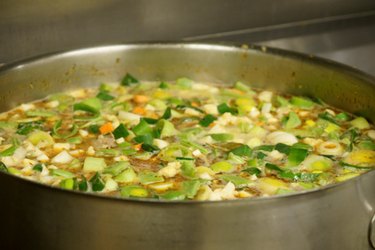
Whether you make your own broth or cream-based soup from scratch or reach for a can for a comforting bowl of soup, you are surely looking forward to a satisfying, well-blended soup. Unfortunately, it is not uncommon to open a can and find separated fat from the broth or separated and lumpy cream soups. There are a few reasons this happens, and in most cases, you can correct the problem.
Separating Fat From Broth
Video of the Day
One potential cause of soup separation is fat separating from the broth. It is well known that oil, a fat, and water don't mix. And many soups may have both a water-based broth and a fat source, such as oil or animal fat from chicken or beef, added to the soup.
Video of the Day
While you can usually mix some of the fat back into the broth when you reheat it, if you want to get rid of the excess fat, there is a method for how to separate the fat from the broth. The fat will rise to the surface, and you can use a spoon to skim it off the hot broth. An even easier method is to remove the fat while the soup is still cold. The fat will harden when you refrigerate the soup, and you can use a spoon to scoop it out.
Soup Separation After Freezing
Freezing your soup may also cause separation. There are a few reasons this may occur depending on the ingredients in your soup. Starches, such as flour and cornstarch, will lose the properties that allow them to act as a thickening agent when they are frozen. As a result, your soup may separate when it is thawed. Soups will usually come back together when you reheat them with some mixing, but in some cases, you may need to add another thickening agent.
Vegetable soups are also affected when they are frozen. When water freezes, it expands, and since vegetables have high water content, freezing can cause the water in the vegetables to seep out of the cells and into the broth. The water will separate, and the heavier vegetables will sink to the bottom of the container. This type of soup separation is especially noticeable when the vegetables are pureed, such as in a tomato soup.
Cream-Based Soup Separation
Freezing a cream-based soup will also cause it to separate. Cream soups may also curdle or separate when the dairy ingredients are boiled or heated too fast. You may find that there is a layer of water on top of the soup and that the soup takes on a grainy consistency.
This doesn't usually affect the taste of the soup, and with patient reheating, you may be able to solve the separation problem. Take the time to put the frozen soup in the refrigerator to thaw. Then, reheat the soup slowly and stir it frequently. Make sure you don't boil the soup.
If you know you will have leftovers, it can help to divide the recipe and only add the dairy component to the portion you are eating fresh. Then, when you are ready to reheat the remaining part of the recipe, add the rest of the dairy. This helps to prevent the separation problem altogether.